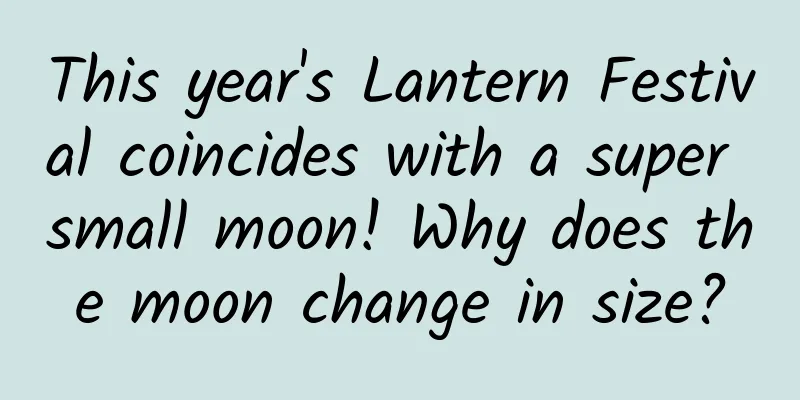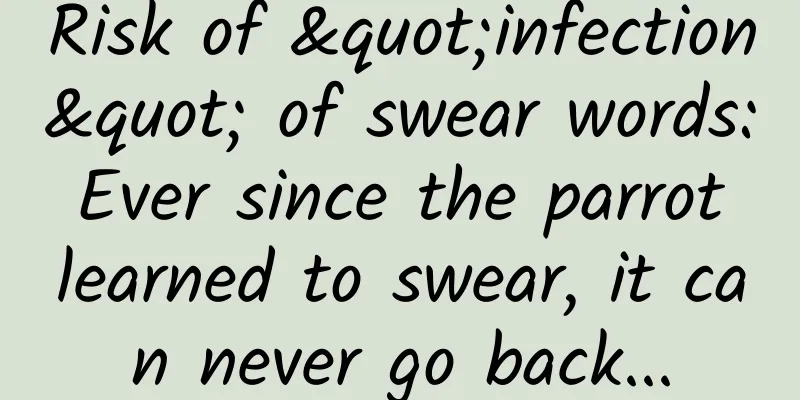This year's Lantern Festival coincides with a super small moon! Why does the moon change in size?

|
This year's Lantern Festival happened to be the smallest full moon of the year, with an apparent diameter of only 29.44 arc minutes. How small is it? For example, the largest full moon this year was on the 15th day of the ninth lunar month, with an apparent diameter of 33.44 arc minutes. Compared with it, the full moon of this year's Lantern Festival is 12% smaller. This difference should be said to be quite obvious. If you use a camera or mobile phone to take pictures of these two full moons this year, you will easily find the difference in size between the two. So why is there such a big difference in the size of the moon? The reason why the moon appears in different sizes is not because the size of the moon itself has changed, but because the distance between the moon and the earth has changed. We all know that the moon revolves around the earth. If its orbit around the earth is a circle, then the distance between the earth and the moon will not change, and the moon will always look the same size. But in fact, the moon's orbit around the earth is an ellipse, so the distance between the earth and the moon is variable. The point closest to the earth on this elliptical orbit is called the perigee, and the distance between the earth and the moon is about 363,000 kilometers, while the point farthest from the two is called the apogee, which is about 406,000 kilometers. Therefore, from the earth, the size of the moon is variable, and its apparent diameter is more than one-tenth smaller when it is smallest than when it is largest. However, because the Earth is also orbiting the Sun as the Moon orbits the Earth, the time period between the Moon's two consecutive passes through the apogee (or perigee) is not the same as the period of the Moon's waxing and waning. The former is about 27.55 days, while the latter is about 29.53 days. Therefore, the Moon's smallest or largest apparent diameter does not appear on the same day of each month. In other words, the size of the Moon will definitely look different every full moon in a year. In this way, if the moon happens to be near perigee during the full moon of a certain month, the full moon of that day will look particularly large. Similarly, if the moon happens to be near apogee during the full moon of a certain month, the full moon of that day will look particularly small. Furthermore, looking at the whole year, if at the moment of the full moon of a certain month, the moon is closest to the perigee, then this full moon is the largest in the year. Similarly, if at the moment of the full moon, the moon moves closest to the apogee, then this full moon is the smallest in the year. Of course, generally speaking, people prefer full moons that look bigger, so if a full moon is the biggest full moon of the year, people call it a "supermoon". In fact, this concept refers to a super "big" moon. In fact, in contrast, the smallest full moon is also very special and can also be called a "supermoon", but it is just super "small". This year's Lantern Festival has the smallest full moon of the whole year. Although it is not the smallest full moon in the previous and next few years, it is the Lantern Festival that coincides with the smallest full moon of the whole year, or it can be called the Lantern Festival coinciding with the "super small moon", which is a very rare phenomenon. I checked the data and found that the Lantern Festival coincides with the smallest full moon of the year, which was quite rare in the past. And it is even rarer to have a full moon as small as this year's Lantern Festival. The data shows that in the past 70 years, the full moon of the Lantern Festival has never been as small as this year, and in the next 70 years, the full moon of the Lantern Festival will not be smaller than this time. The smallest full moon that can really be compared with this time is the smallest full moon of the Lantern Festival on February 28, 2086, with an apparent diameter of 29.42 arc minutes, which is only 7/10,000 smaller than this time. But that happened more than 60 years later. Author: Qi Rui, Deputy Director of Beijing Planetarium Reviewer: Han Wenbiao, Researcher, Shanghai Astronomical Observatory, Chinese Academy of Sciences Produced by: China Association for Science and Technology Department of Science Popularization Producer: China Science and Technology Press Co., Ltd., Beijing Zhongke Xinghe Culture Media Co., Ltd. |
>>: How to show your "scientific literacy" when others are playing in the snow? | Expo Daily
Recommend
The beautiful sunset can actually be predicted. When do you think it will appear again?
On May 14, the news that "a beautiful sunset...
An excellent Android application starts with building a project
[[142392]] 1. Project Structure The MVP model is ...
What kind of rice is the "rice" in Travel Companion's "self-heating rice"?
During holidays, people often encounter inconveni...
Apple may remit funds to Chinese developers at a 1:1 exchange rate between RMB and USD
[[275889]] Several Chinese iOS developers said on...
The mantle is solid, so how did the oceanic crust subduct into it?
There is a question on Zhihu: "The mantle is...
Mr. Yuefeng's first lecture 20190215 Institutional Training 1-Employee New Edition Handout Training (Video) Total 4
Mr. Yuefeng's first lecture 20190215 Institut...
A must-read for marketers: 5 senses and abilities you must master!
I have read many marketing books and found that t...
LeEco Super 4 Max65 first review: Home theater is the ultimate goal of living room entertainment
Undoubtedly, the greatest contribution of the bir...
iOS: How to catch exception?
Table of Contents 1. System Crash 2. Processing s...
Baiyang SEO Precision Drainage Issue 3
This course is from Baiyang's course worth 2,...
Weibo Fantong & self-media traffic, how to make 1 million per month?
Preface | As everyone has experienced—— iPhones h...
Ground-based economy: the most traditional mode of operation and the most economical mode of attracting new customers
1. Team Building In terms of team building, the c...
The truth behind the new Macbook Pro's battery life is revealed: The conclusion is speechless
Not long ago, Apple began to urgently recruit eng...
It’s too dazzling to use mobile phone at night. Is it useful to turn on night mode?
In the information age, mobile phones have penetr...
Rolls-Royce's first SUV official spy photos revealed
Recently, Rolls-Royce released two official spy p...









